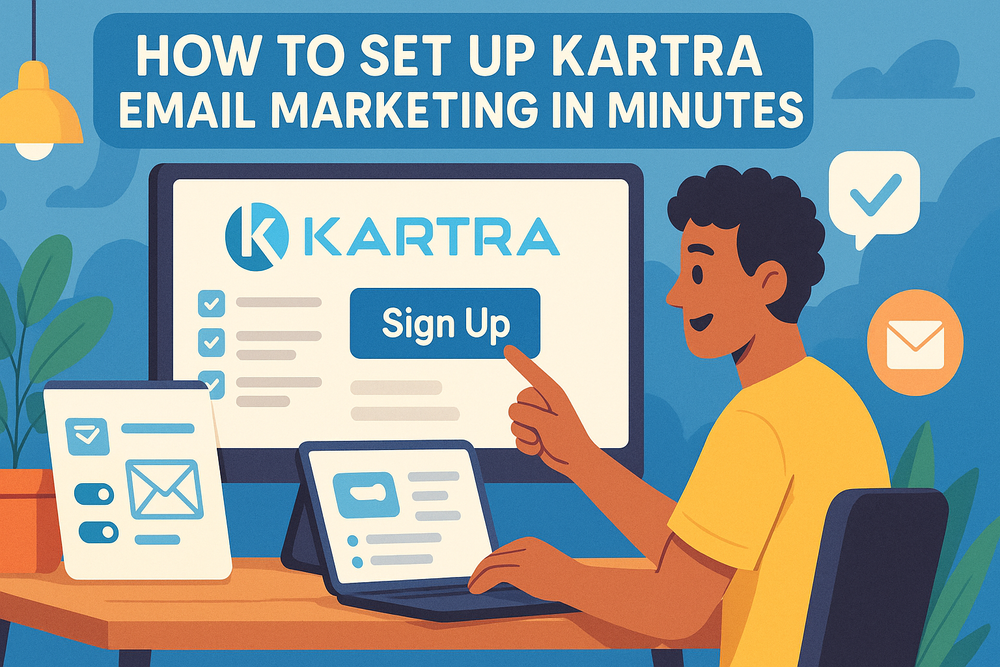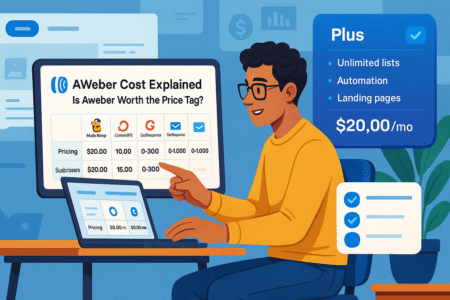Table of Contents
Struggling to get your Kartra email marketing up and running? Not sure how to connect your forms, set up automations, or build a sequence that actually converts? You’re not alone—and the good news is, this doesn’t have to be complicated.
Kartra Email Marketing brings powerful automation tools, beautiful templates, and built-in list management under one roof. But when you’re just starting out, it’s easy to feel overwhelmed by all the options. How do you create your first list? What’s the fastest way to launch a campaign? And how do you track what’s actually working?
In this guide, I’ll walk you through the exact steps to set everything up in just minutes—without needing a tech background or outside tools. Let’s break it down together and get your email system working for you, not against you.
Understand What Makes Kartra Email Marketing Unique
Kartra email marketing stands out because it’s not just an email tool—it’s part of a complete business ecosystem. Before diving into setup steps, it helps to understand how Kartra is different and why that can work in your favor.
Explore Kartra’s Built-In Automation Capabilities
If you’ve ever used traditional email platforms, you know how clunky automation can get. You create a sequence, then jump into a separate tool to build landing pages, another to manage contacts, and maybe one more to handle tagging or analytics. It gets messy fast.
Kartra flips that experience on its head. The automation features are built directly into the platform, meaning everything from lead capture to follow-up emails happens in one seamless flow. You don’t have to duct tape together different tools to build a campaign. Instead, Kartra lets you:
- Create automated email sequences with a drag-and-drop visual builder
- Set behavior-based triggers like link clicks, page visits, or purchases
- Assign dynamic tags and segment your list without leaving the email editor
- Automatically unsubscribe, retarget, or upsell based on real-time activity
This kind of native automation doesn’t just save time—it helps you deliver smarter, more personal messages based on what your subscribers actually do.
Let me give you a quick example. Say someone opts in to a lead magnet and clicks a specific link in your first email. Kartra can automatically tag that person as “Interested in Product A,” move them into a product-specific sequence, and stop the original campaign—all without you lifting a finger. It’s like having a virtual assistant running your emails 24/7.
How Kartra Combines CRM, Pages, and Email Seamlessly
The real power of Kartra lies in how it blends marketing tools under one roof. You’re not just getting an email platform—you’re getting a full CRM, landing page builder, checkout system, and membership site creator rolled into one.
Here’s how that helps your email marketing:
- Customer data is always connected. You can see every email opened, page visited, form filled, and product purchased—all in one place. This gives you a complete picture of each contact.
- Your landing pages and forms are synced. No need to copy-paste code or use third-party form plugins. Kartra’s forms directly feed into your email list and automation workflows.
- Campaigns are easier to build. You’re not bouncing between tools or worrying about integrations breaking. When you build a funnel in Kartra, your email, pages, and sequences are already talking to each other.
This integration is a huge win for solo entrepreneurs, small teams, or anyone who doesn’t want to play tech support when launching a new email sequence.
Let’s say you want to promote a webinar. With Kartra, you can build the registration page, the email reminders, the replay page, and the follow-up sales campaign—all within a single workflow. You don’t need Zapier. You don’t need to embed forms or juggle API keys. It just works.
Why You Don’t Need Third-Party Tools with Kartra
One of the biggest time drains in digital marketing is managing all your software. Email platforms, form builders, checkout tools, CRMs—they add up quickly, and so do the costs. But with Kartra, that stack gets a whole lot leaner.
Here’s what Kartra replaces for most users:
- Email marketing software like Mailerlite, Aweber, or ConvertKit
- Landing page builders like Leadpages or ClickFunnels
- CRM tools like HubSpot or Keap
- Checkout and cart systems like SamCart or ThriveCart
- Video hosting with engagement tracking (built into Kartra’s video module)
- Calendar and scheduling tools for coaching or consulting sessions
Now, I’m not saying you’ll never want to use another tool—but for many small businesses and solo creators, Kartra can handle 90% of your marketing workflow in one dashboard.
It’s also worth noting that fewer tools means fewer things to break. You’re not waiting on integrations to sync or worrying about version compatibility. Everything updates together, works together, and reports data in one place.
If you’ve ever launched a campaign only to find out an email didn’t send because a tag didn’t transfer from another tool, you know how frustrating that can be. Kartra’s all-in-one system minimizes those issues. That kind of reliability makes your workflow simpler and your results more predictable.
Create Your First List Inside Kartra
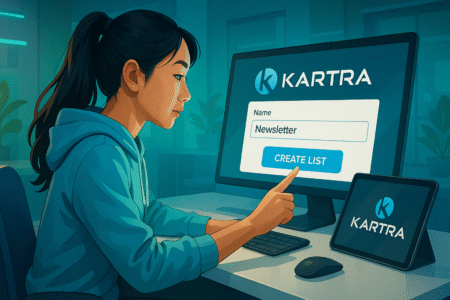
Before you send a single email, you need a clean, organized list to send it to. Kartra makes list creation simple, but how you set it up can affect how well your campaigns perform later on.
Step-by-Step: Building a New List from Your Dashboard
Creating your first email list in Kartra only takes a few clicks, but each step matters. Let me walk you through the process so you can avoid common mistakes right from the start.
Here’s how to build your list:
- Log into your Kartra dashboard and click on the “My Communications” tab.
- Choose “Lists” from the sidebar, then hit the green “+” button to create a new list.
- Give your list a clear name—something that helps you instantly recognize its purpose. For example: “Free Ebook Opt-Ins” or “Course Launch 2025.”
- Add a description (optional, but helpful if you manage multiple lists).
- Choose whether you want this list to be single or double opt-in. I’ll talk more about that in a bit.
- Click “Create List.” You’re done!
From there, you can start attaching opt-in forms, adding tags, or linking it to automation sequences.
One tip I’ve learned: Keep your list naming simple and specific. You’ll thank yourself later when you’re juggling five or ten different campaigns.
Tips for Segmenting Subscribers for Higher Engagement
Creating a list is the easy part—organizing it for maximum engagement takes a bit more thought. This is where segmentation comes in.
Segmentation means splitting your audience into smaller groups based on behavior, interest, or demographics. And Kartra makes this surprisingly easy through its tagging system and custom fields.
Here are a few smart ways to segment your list in Kartra:
- By lead magnet or opt-in source: Know what content brought them in
- By behavior: Tag based on email opens, link clicks, or video views
- By purchase history: Separate buyers from prospects automatically
- By interest: Use quizzes, forms, or surveys to tag interests and goals
Let’s say you offer two different services: marketing coaching and website design. If someone signs up for your “Top 10 Web Design Tips” guide, Kartra can automatically tag them as “Web Design Interest.” You can then follow up with a targeted email sequence instead of a generic one.
This approach helps you:
- Write more personalized emails
- Increase open and click-through rates
- Avoid annoying your subscribers with irrelevant content
You don’t need dozens of tags to get started—just two or three smart ones will go a long way. And over time, you’ll learn more about what your audience wants based on how they engage with your emails.
How to Customize Confirmation Settings and Opt-In Flow
One of the first choices you’ll face when setting up a list is whether to use single or double opt-in. There’s no one-size-fits-all answer, but I’ll break down what each option means so you can decide what works best for your situation.
Single opt-in:
This means subscribers are added to your list immediately after filling out your form. It’s frictionless and fast, which can help you grow your list more quickly.
Double opt-in:
After submitting their info, the subscriber receives an email asking them to confirm. Only after clicking that link are they added to your list. This helps you maintain a cleaner, more engaged list and can improve email deliverability.
In Kartra, you can customize this process:
- Go to your list’s settings
- Choose the opt-in method you prefer
- For double opt-in, you can edit the confirmation email and thank-you page
- Set a redirect URL so people land on the right page after confirming
You can also customize what happens after someone joins your list:
- Send them a welcome email automatically
- Trigger a campaign based on tags
- Redirect them to a thank-you page with a special offer
The key here is to make the experience feel seamless. A clunky opt-in process can lead to drop-offs or unsubscribes before your sequence even starts.
One trick I use? Always test your opt-in flow from the subscriber’s perspective. Fill out your own form and go through the emails, confirmation pages, and redirects to make sure nothing feels broken or confusing.
Set Up a High-Converting Email Sequence
Once you’ve got your list in place, the next step is where the real magic happens—creating an email sequence that actually converts. Kartra makes this process intuitive with its visual builder and smart automation features.
Create Automated Campaigns with the Visual Sequence Builder
One of my favorite features in Kartra is the visual sequence builder. If you’ve ever felt lost in endless automation settings or struggled to understand how your emails fit together, this tool is a game changer.
Here’s how it works:
- You start by dragging and dropping different blocks onto a canvas—things like emails, delays, triggers, and conditions.
- Each step in your sequence is laid out visually, so you can literally see how subscribers will move through your campaign.
- You can customize each block to match your specific workflow, whether that’s sending a welcome email, offering a discount, or following up with non-openers.
Let’s walk through an example. Imagine someone opts in for your free mini-course. You might build a sequence like this:
- Immediate welcome email with login info
- Wait two days
- Send lesson two
- Wait one day
- Send a helpful resource with a soft offer
- Tag them based on whether they clicked the offer
- Branch the sequence: one for those who clicked, one for those who didn’t
With Kartra’s builder, this whole process is visual. You’re not staring at lines of settings—you’re dragging, dropping, and tweaking as needed. It’s especially helpful if you’re a visual thinker or new to automation.
And here’s the best part: You don’t need to build everything from scratch. Kartra offers pre-built campaign templates that you can load, tweak, and launch in minutes.
Use Tags and Triggers to Personalize the Customer Journey
Generic email blasts rarely perform well. What really moves the needle is personalization—and in Kartra, that’s where tags and triggers come in.
Tags are basically labels you can attach to contacts based on what they do (or don’t do). Triggers are the events that cause something to happen in your automation—like sending an email, assigning a tag, or starting a new sequence.
Here’s how you can use them to shape a personalized journey:
- Tag subscribers when they opt in through different lead magnets so you know their interests
- Trigger different sequences based on whether someone clicks a link or ignores it
- Remove subscribers from one campaign when they move into another (no awkward duplicate emails)
- Score leads over time based on engagement and purchase behavior
Think of it this way: Tags help you know who someone is, and triggers help you decide what to do next.
Let’s say someone clicks a link in your email about advanced training. Kartra can automatically tag them as “Advanced Interest” and start a sequence with deeper content or a premium offer—without you doing a thing.
This kind of smart automation means you’re sending the right message at the right time, which builds trust and boosts conversions.
You don’t have to go overboard here. Even a few well-placed tags and a simple trigger can dramatically improve how your emails perform.
Best Practices for Timing and Frequency That Convert
Now that your sequence is mapped out, there’s one more piece that often gets overlooked: timing. Even the best email won’t convert if it lands at the wrong time—or if you’re overwhelming your list with too many messages.
Here’s what I’ve learned through trial, error, and a lot of testing:
1. Space out your emails thoughtfully.
Start with one every 1–2 days, especially during a new subscriber sequence. This gives people time to read, respond, and engage without feeling bombarded.
2. Use delays to create breathing room.
Kartra allows you to insert delays between emails based on hours or days. Use these to avoid sending messages too close together.
3. Pay attention to open and click behavior.
If someone isn’t opening emails after three or four messages, it may be better to pause the sequence or try a re-engagement campaign.
4. Test different send times.
There’s no universal “best time” to send, but Kartra’s analytics make it easy to see what works for your audience. Try mornings vs. afternoons and weekdays vs. weekends.
5. Use frequency caps in long-term campaigns.
For evergreen nurture sequences, aim for one email per week or every 10 days to keep engagement up without burning out your list.
Also, don’t be afraid to ask your subscribers how often they want to hear from you. A quick survey or preference center can go a long way in improving satisfaction and reducing unsubscribes.
Design Beautiful, Responsive Emails Fast
Well-designed emails aren’t just about aesthetics—they influence how your audience connects with your message. With Kartra, creating responsive, attractive emails doesn’t require design experience or coding knowledge.
How to Use Kartra’s Drag-and-Drop Email Editor
Kartra’s email editor is intuitive and beginner-friendly. You don’t need to write a line of code or worry about formatting—it’s all about clicking, dragging, and dropping elements into place.
Here’s how to get started:
- Go to the My Communications section and choose Broadcasts or Sequences depending on your goal.
- Click Create New Email, then choose between the classic editor or drag-and-drop editor. (The drag-and-drop version gives you more flexibility.)
- Use the content blocks on the left—like headlines, images, buttons, or dividers—and drag them into your layout.
- You can easily style each element with fonts, padding, alignment, and colors that match your brand.
- Preview your email across devices before saving. Kartra allows real-time mobile previews which is super helpful.
This editor is especially useful for building visually appealing emails that look polished without the usual design overwhelm. Whether you’re promoting a product, sharing a blog post, or delivering course content, you can get it looking professional in minutes.
If you ever feel stuck, Kartra offers template blocks you can drag in as starting points—then just swap out the text and images.
Import Templates or Build Your Own From Scratch
Kartra gives you the flexibility to either start with a blank canvas or use one of their pre-designed templates. This is perfect whether you’re a DIY type or just want to get something out the door quickly.
Here’s what each option offers:
- Pre-made templates: Kartra has a library of ready-to-use email layouts for newsletters, promos, launches, and more. Just choose one, update your content, and you’re ready to go.
- Custom templates: You can design your own from scratch, save it, and reuse it for future broadcasts or sequences.
- HTML import: If you’ve already got email designs from another platform, you can bring them into Kartra using the code editor.
Having reusable templates can really speed things up. For example, you might create one for weekly newsletters and another for product launches. That way, all you have to do is tweak the message, not start over every time.
I suggest starting with a simple layout that you can consistently use—then refine as you go. Clean, consistent design helps build brand recognition and makes your emails easier to read.
Mobile Optimization Tips to Maximize Open Rates
A huge percentage of your subscribers are checking emails on their phones, so mobile design matters—big time. If your email doesn’t display well on mobile, you risk losing attention before they even scroll.
Here are some tips to keep things mobile-friendly in Kartra:
- Keep subject lines short. Aim for 6–8 words so they don’t get cut off on smaller screens.
- Use single-column layouts. These are much easier to read on mobile than multi-column designs.
- Make fonts legible. Stick to 16px or larger for body text and avoid ultra-thin fonts.
- Use buttons over links. Buttons are easier to tap and stand out more on mobile.
- Check the preview. Kartra lets you toggle between desktop and mobile views so you can fix layout issues before sending.
Small adjustments like these can significantly increase your email engagement. In my experience, simplifying your design and focusing on clarity works far better than packing too much into one message.
Connect Your Opt-In Forms to Email Campaigns
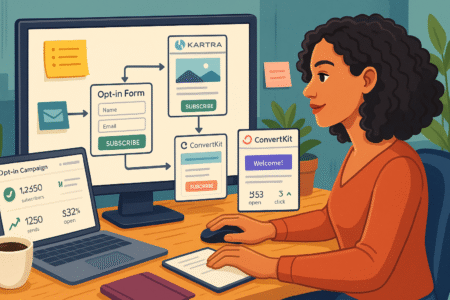
Connecting your forms to the right campaigns is where your email marketing truly starts working. Kartra simplifies this process by linking everything together behind the scenes—but a little strategy goes a long way.
How to Add Forms to Landing Pages or Popups in Kartra
Every subscriber journey begins with a form, and in Kartra, adding one is quick and straightforward. You can embed forms in your landing pages, popups, or even inside video overlays.
Here’s how to do it:
- Go to My Forms and click + Create Form.
- Choose your form type (inline, popup, or embedded).
- Customize the fields—usually name and email, but you can add custom fields if needed.
- Set the list the form should feed into.
- Go to My Pages, open the page builder, and drag in the Form block where you want it to appear.
- Choose the form you just created and save your page.
Kartra forms are mobile-optimized and fully integrated, which means no copying code or messing with third-party plugins. You can even A/B test different forms on the same page using Kartra’s built-in tools.
One little tip: Customize the thank-you message or redirect page to make the sign-up feel personal and rewarding.
Automate What Happens After Someone Submits a Form
Once someone submits your form, what happens next is crucial. Kartra gives you complete control over this flow using automation rules.
After form submission, you can:
- Add the subscriber to one or more lists
- Assign tags to define their interest or entry point
- Subscribe them to an email sequence immediately
- Redirect them to a confirmation or sales page
- Trigger internal notifications for your team
Let’s say someone signs up for a lead magnet. Kartra can tag them with “Lead Magnet A,” drop them into a welcome sequence, and redirect them to a thank-you page—all in a single action.
To set this up:
- Open your form settings.
- Go to the Automation Rules tab.
- Choose what actions to trigger based on form completion.
- Click Save & Exit.
These small steps ensure every new subscriber gets a warm welcome—and you never miss an opportunity to engage them from the start.
Common Mistakes to Avoid When Linking Forms to Lists
This part might seem simple, but it’s where a lot of users hit snags. I’ve made a few of these mistakes myself, so here’s how to avoid them:
- Forgetting to connect the form to a list. If no list is selected, contacts won’t be saved—even if the form works. Always double-check the list selection.
- Not adding follow-up actions. A form without an email sequence or tag is a missed opportunity. Make sure every form has a next step.
- Using the wrong list or duplicate lists. Keep your naming consistent and avoid clutter. Too many overlapping lists can get confusing fast.
- Skipping testing. Always test your form live. Fill it out yourself to make sure contacts are added properly and automation fires as expected.
Taking a few extra minutes to double-check your setup can save hours of troubleshooting later.
Use Kartra’s Analytics to Track and Optimize Emails
Understanding how your emails perform is key to improving engagement and conversions. Kartra’s built-in analytics provide real-time insights so you can see what’s working—and fix what’s not.
Monitor Open Rates, Click Rates, and Revenue Metrics
When it comes to measuring email success, it’s not just about how many people open your message. Kartra helps you go deeper by tracking the metrics that actually matter.
From your dashboard, you can view:
- Open rates – the percentage of subscribers who opened your email
- Click-through rates (CTR) – how many clicked on a link inside your email
- Unsubscribes – helpful to spot if a message turned people away
- Revenue generated – for sales emails, Kartra connects purchases back to specific emails
The cool thing about Kartra is that it doesn’t stop at surface-level stats. It ties every click to the customer journey. So if someone clicks an offer and makes a purchase later, you can see exactly which email played a role.
Here’s why these numbers matter:
- Low open rates may mean your subject lines need work
- Low CTR could signal weak calls-to-action or confusing layouts
- High unsubscribe rates might mean your content isn’t aligned with expectations
- Revenue metrics help you pinpoint the true ROI of each email
Instead of guessing, you get clarity—and that lets you make smarter decisions with every campaign.
How to A/B Test Subject Lines and Email Designs
Sometimes small changes make a big difference. That’s where A/B testing comes in. In Kartra, you can test two versions of the same email to see which one performs better—and the system can automatically send the winner to the rest of your list.
You can A/B test:
- Subject lines
- Email content (like copy, images, or layout)
- Call-to-action placement or style
- Send times
Here’s how to set up a simple A/B test in Kartra:
- Go to your email campaign or broadcast and choose the A/B test option.
- Create Version A and Version B with one key difference (like the subject line).
- Decide how much of your list gets the test (usually 10–20%).
- Kartra automatically sends the rest of the emails based on which version performs better within a time window you define.
If you’re just getting started, I suggest testing subject lines first. They’re the gatekeepers of your emails, and even a small tweak—like adding curiosity or personalization—can lead to a noticeable bump in opens.
You don’t need to run complicated tests. Just focus on one variable at a time, keep track of the results, and adjust your future emails accordingly.
What to Do If Your Email Metrics Are Underperforming
Sometimes, despite your best efforts, the numbers just don’t look great. If that happens, don’t worry—it happens to all of us. The key is figuring out why and making thoughtful improvements.
Here are a few common issues and how to troubleshoot them:
- Low open rates? Try rewriting your subject lines. Add urgency, curiosity, or personalization.
- Low click rates? Simplify your call-to-action. Make sure your buttons are easy to see and not buried in too much text.
- High unsubscribe rates? Review your content and frequency. Are you sending too often? Are your emails still delivering value?
- Poor deliverability? Check your domain settings and avoid spammy language (like “100% FREE” or “Buy Now”).
It’s also helpful to ask for feedback. Send a quick email inviting replies—ask what kind of content your subscribers want more (or less) of. You might be surprised at the insight they give you.
Kartra makes it easy to spot underperforming sequences or broadcasts, so you can tweak, test, and turn things around without starting from scratch.
Leverage Kartra’s Lead Scoring and Behavior Tracking
One of Kartra’s most powerful features is its ability to track how leads engage with your content over time—and then score and segment them automatically. This is where your email marketing can shift from basic to advanced.
How Kartra Automatically Scores Your Leads Over Time
Lead scoring might sound complicated, but in Kartra, it’s surprisingly simple. Every action your subscribers take earns them points—and those points help you identify who’s most engaged.
Here’s how it works:
- Opening emails, clicking links, visiting pages, watching videos, or buying products all contribute to a lead’s score.
- You can assign different point values to different actions. For example, clicking a link might be worth 5 points, while making a purchase is worth 50.
- As scores increase, you can trigger different automations—like enrolling high-scoring leads into a more advanced sequence.
Lead scoring helps you focus your time and energy on the people most likely to convert. Instead of sending the same emails to everyone, you’re zeroing in on the folks who are already warmed up.
I recommend reviewing your lead scores every couple of weeks. Who’s showing strong interest? Who’s gone cold? This insight can shape your follow-up strategy in a meaningful way.
Trigger Actions Based on Clicks, Page Views, and More
Kartra lets you set up real-time automations that fire based on behavior. This is where things get really smart.
You can trigger actions like:
- Tagging someone when they click a certain link
- Sending a follow-up email when someone visits a pricing page
- Redirecting a lead to a new sequence after they watch a video
- Removing someone from a campaign if they’ve already purchased
Let’s say you run a webinar and want to follow up with those who attended versus those who registered but didn’t show up. Kartra tracks this and lets you automate two completely different follow-ups, each tailored to the person’s behavior.
It may take a little setup up front, but once these automations are in place, your system works around the clock—building trust, answering objections, and moving people closer to a sale without you manually intervening.
Segment Lists Dynamically Using Real-Time Behavior
Segmenting your list doesn’t have to be a one-time thing. With Kartra, you can build dynamic segments that update automatically as people’s behavior changes.
For example:
- Create a segment of “Highly Engaged Leads” with a score of 70+
- Segment by people who visited a sales page but didn’t buy
- Create a list of cold leads who haven’t clicked an email in 60+ days
These dynamic lists are always up-to-date. No exporting, importing, or spreadsheet headaches. And because they’re connected to your automation workflows, you can build personalized paths for each segment that feel thoughtful and relevant.
The best part? You can build these segments visually using filters and logic inside Kartra. No code or complicated rules required.
Launch an Automated Campaign in Under 15 Minutes
Getting a full campaign live doesn’t have to take hours—or even a full afternoon. Kartra makes it possible to launch an automated email campaign quickly, especially when you use their templates and smart integrations.
Use the Pre-Built Campaign Templates for Instant Setup
One of the fastest ways to get started is with Kartra’s done-for-you campaign templates. These aren’t just layouts—they’re fully built funnels with opt-in pages, emails, automation steps, and tagging already in place.
Here’s how to use one:
- Go to the Campaigns tab and select Done-For-You Campaigns.
- Browse the available options—Kartra offers templates for lead generation, product launches, webinar follow-ups, and more.
- Choose the one that fits your goal and click Deploy.
- Once deployed, Kartra adds all the assets (emails, pages, sequences, forms) to your account, ready for customization.
You don’t need to reinvent the wheel. These templates give you a proven framework that’s easy to adjust with your brand voice, offer, and audience in mind.
If you’re just getting started with Kartra email marketing, this approach gives you a massive head start—and helps you avoid missing steps in your setup.
Plug in Your List, Emails, and Pages—Fast Integration
After loading a template or building your own sequence, the next step is connecting all the pieces. Kartra is designed to keep this simple with a drag-and-connect style workflow.
Here’s a quick setup checklist:
- Select your email list: Make sure your form or opt-in page feeds into the correct list.
- Review your emails: Update the subject lines, add your copy, and make sure links point to the right pages.
- Check tags and sequences: Verify that the right tags are applied and the right follow-ups are triggered.
- Connect landing pages: Link opt-in forms to thank-you or confirmation pages.
- Test your flow: Run through the experience yourself—from signup to email delivery—to make sure it all works smoothly.
Kartra’s ecosystem means everything talks to each other. Once you plug your list and emails into a sequence, the automation takes care of the rest.
You’re not bouncing between platforms or copying data manually, which makes the whole setup process incredibly efficient.
Checklist: What to Review Before You Hit “Go Live”
Even with fast setups, a final review is worth your time. A few minutes spent double-checking the details can save you from missed leads or broken funnels later.
Here’s a pre-launch checklist to run through:
- Have you proofed every email for typos, broken links, and formatting?
- Is your list connected properly to the form and campaign sequence?
- Are the tags assigned correctly for tracking and follow-ups?
- Have you previewed your emails on both desktop and mobile?
- Are your confirmation pages or thank-you pages set up and branded?
- Have you tested the entire funnel as a subscriber to see the full experience?
Kartra’s preview and test options make this easy. Send a test email to yourself and walk through each step like you’re a new lead.
If you catch anything, now’s the time to fix it—before your campaign goes out to dozens or hundreds of people.
Troubleshoot Common Setup Issues Quickly
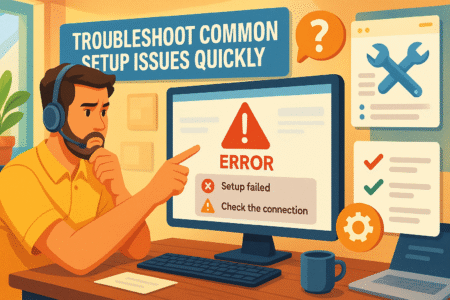
Even with a smooth system like Kartra, things don’t always go perfectly. The good news? Most common issues have quick fixes—and knowing where to look can save a lot of frustration.
How to Resolve Email Deliverability or Spam Folder Problems
If your emails are landing in spam or not reaching your audience, there are usually a few key things to check.
Here’s what to look at:
- Authenticate your domain: Make sure DKIM and SPF records are set up. Kartra gives you the DNS info to add on your domain host.
- Avoid spam trigger words: Terms like “free,” “guarantee,” or “act now” can lower deliverability. Keep your subject lines and content clean and conversational.
- Ask subscribers to whitelist your address: This boosts your sender reputation.
- Use a business domain email (like hello@yourbrand.com) instead of free services like Gmail or Yahoo.
You can also use Kartra’s analytics to spot trends. If your open rates are consistently low across campaigns, it may be a deliverability issue worth digging into.
Fixing Broken Links or Form-to-List Connections
This is another common stumbling block—usually easy to fix once you know where to look.
Here’s how to troubleshoot:
- Check form settings: Make sure your form is set to send contacts to the correct list or sequence. If nothing happens after submission, it’s often a missed link here.
- Test every link: Go through your emails and landing pages and manually click every link to confirm it works. Redirects, typos, or outdated URLs can easily sneak in.
- Review automation rules: Inside each form or sequence, confirm that rules (like tagging or sequence entry) are actually saved and active.
If things look good but still aren’t working, try cloning the asset and rebuilding the automation from scratch. Sometimes starting fresh resolves issues you can’t see.
Where to Find Help or Support Inside Kartra
If you’re stuck and can’t figure out what’s wrong, Kartra does offer solid support options.
Here’s where you can turn:
- Help Center: Their searchable knowledge base includes tutorials, setup guides, and troubleshooting articles.
- Live Chat Support: Available directly from your dashboard during business hours.
- Ticket System: Submit a support ticket for more complex issues. You’ll typically hear back within 24–48 hours.
- Kartra Facebook Group: The community is active and helpful. It’s a good place to ask for quick tips from fellow users.
Don’t be afraid to ask for help. Even experienced users run into configuration quirks from time to time, especially when combining different assets or setting up advanced workflows.
Scale Your Email Marketing With Smart Automation
Once you’ve got the basics running smoothly, it’s time to start thinking bigger. Kartra’s automation features can help you scale your email marketing without adding complexity or tech stress.
Clone Winning Campaigns and Reuse High-Converting Emails
One of the easiest ways to scale without reinventing the wheel is to reuse what already works. Kartra makes it simple to duplicate successful sequences, broadcasts, and full campaigns.
Here’s how you can use this to your advantage:
- Clone high-performing email sequences and tweak them slightly for a new segment or offer.
- Duplicate full funnels (including landing pages, tags, automations, and email flows) with one click, saving hours of setup.
- Save winning emails as templates so they’re ready to drop into future campaigns.
For example, if you have a welcome sequence that’s converting well, you can clone it and make a few adjustments for a new lead magnet. The structure stays the same, but the content feels fresh to your new audience.
This lets you move faster and grow more confidently—because you’re not starting from scratch every time.
Integrate Your Email with Kartra Memberships, Courses, and Funnels
Kartra’s strength is in how well it brings everything under one roof. Your emails aren’t floating around disconnected—they’re part of a full ecosystem that includes your products, pages, and customer data.
Here’s how this helps you scale:
- Trigger emails based on course progress. If someone finishes Module 1 in your membership, Kartra can automatically send a “next steps” email.
- Use funnel behavior to shape follow-ups. If someone visits your pricing page but doesn’t buy, tag them and follow up with a special offer.
- Connect checkout behavior to emails. Whether someone abandons a cart or completes a purchase, you can guide the next steps without lifting a finger.
These integrations reduce gaps in your customer journey. Everything becomes more connected, more responsive, and more automated—which means more growth with less manual work.
Tips to Keep Your List Clean and Engaged Long-Term
Scaling doesn’t just mean growing your numbers—it means maintaining the health of your list as it grows. A clean list performs better, costs less to manage, and helps you stay out of spam folders.
Here are some ways to keep things healthy:
- Remove inactive subscribers every few months. If someone hasn’t opened in 90+ days, consider removing or retargeting them.
- Run re-engagement campaigns to win back cold leads before removing them entirely.
- Use tagging over multiple lists. Instead of adding people to different lists, keep them on one list and organize with tags. It keeps your setup lean and easier to manage.
- Let subscribers update their preferences. Include a link to manage frequency or topics in your footer.
I like to think of my list like a garden. You don’t want to just plant more—you want to keep it healthy so everything has room to grow.
Wrap-Up: Get Your Kartra Email System Live in Minutes
You don’t need to be a tech expert to build and launch a complete email marketing system. Kartra brings all the pieces together so you can focus on your message, not the mechanics.
Recap of the Most Time-Saving Features to Focus On
If you’re short on time or just want the fastest route to results, here’s where I suggest focusing:
- Use pre-built campaigns to skip the guesswork and launch faster.
- Start with one list and one welcome sequence.
- Build with the visual sequence builder to simplify your automation.
- Leverage templates and cloning to reduce your workload over time.
- Use tags and behavior triggers to personalize without overcomplicating things.
These features do more than save time—they build a reliable foundation you can grow from.
What to Do Next After Your Campaign Is Live
Once you hit send (or publish), your work isn’t done—but it gets a lot easier.
Here’s what I recommend:
- Monitor performance. Watch open rates, clicks, and revenue to spot early patterns.
- Adjust if needed. A quick subject line tweak or CTA fix can lift results significantly.
- Add to your sequence slowly. Don’t feel pressured to launch a massive funnel right away. One step at a time still moves you forward.
- Ask for feedback. Invite replies and engagement to make your emails a two-way street.
The more you engage with your list, the more insight you’ll gain—and the stronger your emails will become over time.
Expert Tip: Build One Sequence That Converts, Then Scale
If I could offer one simple strategy for anyone starting out with Kartra email marketing, it’s this: Don’t try to do everything at once.
Start with one email sequence that does one thing really well.
Maybe it welcomes new subscribers. Maybe it nurtures them toward a free consult. Maybe it sells your signature product. Whatever it is, focus on making that one sequence as strong as it can be.
Once it’s working, then—and only then—duplicate and scale.
This approach helps you stay clear, stay focused, and actually see results instead of getting overwhelmed by possibilities.


